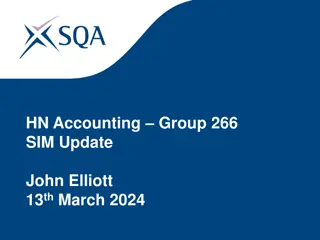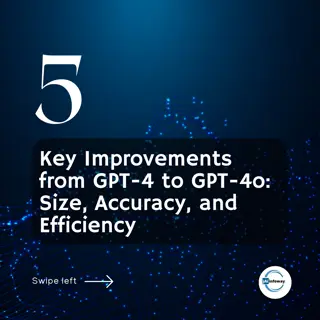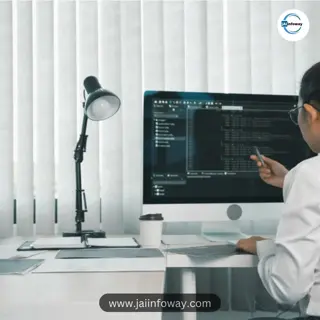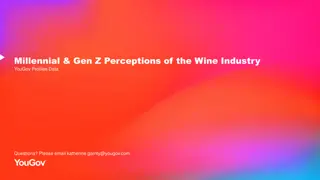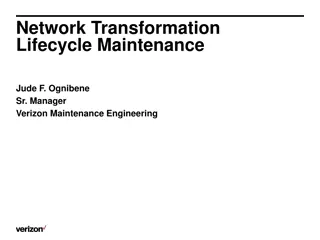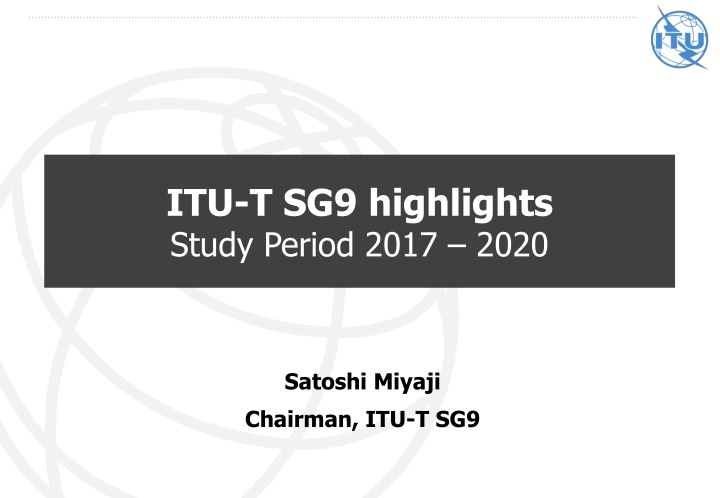
Mandate and Management Structure of ITU-T SG9
Explore the mandate of ITU-T SG9 focusing on television and sound transmission, broadband cable networks, and advanced capabilities. Learn about the management team, current structure, and study highlights from 2017 to 2020.
Download Presentation

Please find below an Image/Link to download the presentation.
The content on the website is provided AS IS for your information and personal use only. It may not be sold, licensed, or shared on other websites without obtaining consent from the author. If you encounter any issues during the download, it is possible that the publisher has removed the file from their server.
You are allowed to download the files provided on this website for personal or commercial use, subject to the condition that they are used lawfully. All files are the property of their respective owners.
The content on the website is provided AS IS for your information and personal use only. It may not be sold, licensed, or shared on other websites without obtaining consent from the author.
E N D
Presentation Transcript
ITU-T SG9 highlights Study Period 2017 2020 Satoshi Miyaji Chairman, ITU-T SG9
Contents 1. Introduction of SG9 2. Cable TV market situation 3. SG9 highlights: Study Period 2017 2020 2
Mandate of ITU-T SG9 (WTSA-16 Res.2) ITU-T SG9: Television and sound transmission and integrated broadband cable networks Responsible for studies relating to: use of telecommunication systems for contribution, primary distribution and secondary distribution of television, sound programmes and related data services including interactive services and applications, extendable to advanced capabilities such as ultra-high definition, 3D, multiview and high-dynamic range television, etc.; use of cable and hybrid networks, primarily designed for television and sound- programme delivery to the home, as integrated broadband networks to also carry voice or other time-critical services, video-on-demand (e.g. over-the-top (OTT)), interactive services, multiscreen services, etc. to customer premises equipment (CPE) in the home or enterprise. Lead Study Group Roles integrated broadband cable and television networks 4
SG9 Management Team Role Name Chairman Vice-Chair Vice-Chair Vice-Chair Mr Satoshi MIYAJI (KDDI, Japan) Mr Blaise Corsaire MAMADOU (Central African Rep.) Mr TaeKyoon KIM (ETRI, Korea Rep. of) Mr Zhifan SHENG (NRTA, China) Role Name Advisor Administrative Assistant Mr Stefano POLIDORI (SGD, TSB) Ms Rosa ANGELES-LEON DE VIVERO (SGD, TSB) 5
Current structure of SG9 SG9 Chair: Mr Zhifan Sheng Vice-Chair: Mr Braise Corsaire Mamadou Video Transport Television and sound transmission Conditional access and content protection Guidelines for implementations and deployment WP1/9 Q1/9 Q2/9 Q4/9 Chair: Mr TaeKyoon Kim Vice-Chair: Mr Eric Wang Terminals and Applications APIs for advanced content distribution services Set-Top Box and terminals Cable television delivery of IP packet-based data (cable modems) Voice and video IP applications over cable television networks Advanced service platforms Q11/9 Accessibility to cable systems and services WP2/9 Q5/9 Q6/9 Q7/9 Q8/9 Q9/9 NEW Q10/9 Work Programme, Coordination and Planning 6
How efficiently cable network carries services J.84 J.118 MATV/SMATV TV broadcasting over the air Cable television network (HFC) Cable TV (multi-channel) J.83 TV Program providers OTTs headend Amplifier amplifier MPEG-TS Modulator node CMTS Internet High-speed Data (cable broadband) J.112, J.122, J.222.x, J.223.x, 1 Telephony networks Cable telephony J.160~J.179, J.360~J.370 household TV signals QAM signals 860 (MHz) 10 54 EMTA cable modem downstream cable modem upstream All the services are modulated and conveyed as RF signals cable modem STB 7
The most popular Recommendation J.83 (1995, 2007) Digital multi-programme systems for television, sound and data services for cable distribution Fundamental technology for digital cable TV transport J.83 is widely deployed to all over the world regardless of the regional digital TV technology standards. One TV bandwidth unit (6MHz/8MHz) can carry two or more HDTV programs. Typical frequency range is, for example, 54 MHz 860 MHz (depending on regions). Cable Television Networks Encode (MPEG-2, H.264, H.265) Set-Top Box (STB) Content 64 QAM or 256 QAM De- Modulation (J.83) Packetization (MPEG-TS) Decode modulation (J.83) Cable Television Headend 8
Cable modem Recommendations Cable modem system provides bi-directional IP communication over one-to- N split networks. Downstream technology is based on ITU-T J.83 with TDM multiplexing. Upstream technology is based on TDMA access control. Two different frequency spectrums are used for downstream and upstream. Cable modem Recommendations SG9 Recommendation DOCSIS Version Downstream capacity (6MHz TV system) 42 Mbps 42 Mbps 42 x n Mbps 42 x n Mbps up to 10 Gbps up to 10 Gbps Upstream capacity J.112 (1998) J.122 (2002) J.222 series (2007) J.223 series (2016) J.225 (2020) J.224 (2019) DOCSIS 1.1 DOCSIS 2.0 DOCSIS 3.0 C-DOCSIS DOCSIS 3.1 (4thgen) DOCSIS 4.0 (5thgen) 10 Mbps 30 Mbps 30 x n Mbps 30 x n Mbps up to 1 Gbps up to 5 Gbps upstream CM downstream TV signals 860 (MHz) CMTS (cable modem termination system) 10 54 Internet CM PC, tablet, etc. (cable modem) 9
SG9 Highlights in the past study periods Digital Cable Television and Emerging IP Technology J.83 (1995): Digital cable TV modulation J.90 (1998): Electronic program guide | J.112 (1998): Cable modem DOCSIS1.0 J.132 (1998): MPEG-TS transport over SDH 2000 DOCSIS2.0, Cable Telephony (VoIP), Optical Transport J.122 (2002): Cable modem DOCSIS 2.0 J.160~J.179: Cable telephony (MGCP) 2001 | 2004 J.185, J.186: Cable TV over FTTH (RF-based) J.190 (2002): Home Network Architecture J.200 J.202: Interactive TV applications DOCSIS3.0, Advanced Television Experience, IPTV J.83rev (2007): 256QAM addition to Annex C J.210 J.214, J.222.0~J.222.3: DOCSIS3.0 J.360 J.370: Cable telephony Ver.2 (SIP) 2005 | 2008 J.601 (2005): Large screen digital imagery J.700 (2007): IPTV framework for cable TV J.901 (2008): Free viewpoint television (FTV) Integrated Broadcast and Broadband, Hybrid Terminal J.205, J.206 (2012, 2013): IBB framework J.295, J.296 (2012): Hybrid set-top box 2009 | 2012 J.380.1 8, J.706, J.707: Target ads J.381 (2012): Advanced cable transport J.603 (2011): 4K/8K real-time transmission Evolution of Transport Technologies J.183rev, J.288 (2016): 4K/8K QAM transport J.195, J.196 (2014 2016): HiNoC v1 and v2 J.223 (2016): Cabinet DOCSIS (C-DOCSIS) 2013 | 2016 J.301, J.302 (2014 2016): Augmented Reality J.382 (2014): DVB-C2 J.1010, J.1011 (2016): Exchangeable CA/DRM 10
Commercialized Recommendations J.382 J.343.1 J.343 series Quality measurement software Video quality evaluation software Demodulator LSI Rohde & Schwarz / Swiss Qual released network quality measurement software for smartphone QualiPoc Android, where J.343.1 (J.bitvqm) quality evaluation method is implemented. Qpticom relased video qualilty evaluation software product PEVQ- S, where J.343.5, J.343.6 (full reference with bitstream analysis) and J.247 (full reference) are employed. In 2016, Sony released the world s first commercial demodulator LSI for advanced digital broadcasting supporting 4K/8K including J.382 for cable TV networks. J.205 J.207 J.295, J.296 J.195, J.196 Hybrid set-top box Hybrid broadcasting system HiNoC modem LSI Haier IC released HiNoC 1.0 LSI (Hi 3601, Hi 309, Hi 2610) capable of 112 Mbps speed at 16 MHz. Hannuo Semiconductor released HiNoC 2.0 LSI (HN1000) capable of 1.14 Gbit/s at 128 MHz bandwidth. In 2010, HbbTV has started in Germany, subsequently deployed in NL, FR, ES, PL, UK, FI, CH, IT, Austraria, New Zealand, Saudi Arabia, etc. In 2013, Hybridcast has been launched in Japan. In 2012, KDDI launched commercial cable TV hybrid set-top box Smart TV Box, which is compliant with J.295 and J.296, equipped with Android operating system. 11
TV households in the world Cable television is still growing and dominant as 35% share in 2021 (forecast). Digital terrestrial TV (DTT) is rapidly growing toward 2021 mainly in developing country. Global TV households by platform (in million) 1,800 1,600 431 289.1 1,400 83 25.5 1,200 198.5 175.8 526.6 1,000 162 255.5 217.2 800 123.8 198.8 594 M 143.1 142.9 563 M 600 528 M 36.3 193.9 400 cable TV cable TV cable TV 463.4 580.4 200 334.1 99.6 2016 14 2021 0 2010 analog cable TV satellite (free to air) digital cable TV analog terrestrial TV IPTV digital terrestrial TV (DTT) satellite (pay TV) Source: Digital TV Research 13
Cable television as broadband access Cable television broadband access is still growing. Cable modem can provide gigabit-class broadband Internet by DOCSIS 3.0 and 3.1. Global fixed broadband subscribers by type (in million) 900 800 700 600 500 400 300 175 M 200 155 M 130 M 100 0 2012 2016 2021 Cable Modem FTTH DSL Source: Broadbandtrends 14
Cable television in the market Global cable television market is still growing as television delivery networks. 1 Cable television is also very important network infrastructure for broadband Internet access. OTT needs such high-speed networks to efficiently provide services to customers. 2 What is cable television expected to be in the future? 15
Cable television in the market Cable television is expected to provide high- realistic entertainment experiences e.g., 4K/8K/VR/AR as strong and efficient network infrastructure for broadcasting as well as ICT convergence to be easy to deploy in developing countries to facilitate rapid deployment ITU-T SG9 has been conducting global standardization on cable television technology more than twenty (20) years as a de jure standardization development organization (SDO). 16
3. SG9 HIGHLIGHTS STUDY PERIOD 2017 2020 17
SG9 Key Missions in 2017 2020 Bridging the Standardization Gap (BSG) considering requirements from various regions implementation and deployment guidelines (Q4/9) Evolution of cable TV networks ultra-high speed cable modems robust and flexible security high-efficiency transport technology, etc. Innovative services advanced definition video experiences (4K/8K/HDR etc.) high realistic experiences (VR/AR etc.) integrated broadcast and broadband services, etc. 18
Increasing the momentum of SG9 Proactive approach in this Study Period (2017-2020) to organize workshops on the future of TV in the regions in collaboration with the three Sectors of the ITU and in co-location with SG9 meetings to promote SG9 and widely invite stakeholders (non-members of ITU-T) to discuss and exchange the latest information on anything related to television technologies and business and to recruit potential new members from cable industry. Workshop collocated with SG9 meeting Workshop attendees 1 Hangzhou, China (May 2017) over 80 attendees 2 Geneva, Switzerland (Jan 2018) over 70 attendees 3 Bogota, Colombia (Nov 2018) over 80 attendees 4 Geneva, Switzerland (Jun 2019) over 90 attendees 19
Increasing the momentum of SG9 2nd 3rd 4th 5th Jan 2018 in Geneva Nov 2018 in Bogota Jun 2019 in Geneva Apr 2020 Virtual Num of Attendees same +55% +11% 45 40 62 69 Num of Contributions +36% same +12% 25 34 33 37 Num of Deliverables (Recs etc.) 4 7 10 19 +75% +43% +19% Sector Members: Associates: (1): Cox Communications (US) (6): CableLabs (US), Skyworth Digital Technology (China), JiShi HuiTong (China), MovieLabs (US), Synamedia (Israel), Sky Group (UK) (1): Indian Institute of Science (India) New members for SG9 Academia: 20
Recommendations approved in this study period (1/4) Rec Q Type Title Consented at Hangzhou meeting (1st) in May 2017 Q2/9 New ITU-T J.1020 Downloadable System for Multi-CA/DRM service of mobile broadcasting; Service Model and Architecture Q7/9 New Requirement for Radio over IP transmission system ITU-T J.1106 Q1/9 ITU-T J.382-rev Rev. Consented at Geneva meeting (2nd) in Jan 2018 Advanced digital downstream transmission systems for television, sound and data services for cable distribution Q5/9 ITU-T J.207-rev Rev. Specification for integrated broadcast and broadband digital television application control framework Q6/9 ITU-T J.297-rev Rev. Requirements and functional specification of cable set top box for 4K ultra high definition television" Q7/9 New Architecture and specification for Radio over IP transmission systems ITU-T J.1107 Q1/9 New Consented at Bogota meeting (3rd) in Nov 2018 ITU-T J.383 Conversion of type length value (TLV) packet and transport stream for advanced cable transmission systems Q5/9 New The functional requirements of smart TV operating system ITU-T J.1201 Q6/9 New ITU-T J.298 Requirements and technical specifications of cable TV hybrid set-top box that has the compatibility with terrestrial and satellite TV transport Q7/9 New Transmission specification for Radio over IP transmission systems ITU-T J.1108 Q7/9 New Requirement for in-band full-duplex in HFC based network ITU-T J.1109 Q9/9 Amd ITU-T J.302amd-1 J.302amd-1 "System specifications of augmented reality smart television service" Q10/9 New ITU-T J.1 Terms, definitions and acronyms for television and sound transmission and integrated broadband cable networks 21
Recommendations approved in this study period (2/4) Consented at Geneva meeting (4th) in Jun 2019 Rec Q Type Title Q1/9 J.288 (J.288-rev) Rev Encapsulation of type length value (TLV) packet for cable transmission systems Q1/9, Q7/9 J.224 (J.5GDOCSIS) New Fifth-generation transmission systems for interactive cable television services IP cable modems Q1/9, Q7/9 J.216 (J.MHAv2) New Second-generation Modular Headend Architecture in systems for interactive cable television services IP cable modems Q2/9 J.1026 (J.oneway-dcas-part1) New Downloadable Conditional Access System for Unidirectional Network; Requirements Q2/9 J.1027 (J.oneway-dcas-part2) New Downloadable Conditional Access System for Unidirectional Network; System Architecture Q2/9 J.1028 (J.oneway-dcas-part3) New Downloadable Conditional Access System for Unidirectional Network; The Terminal Q5/9 J.207 Rev Specification for integrated broadcast and broadband digital television application control framework Q5/9 J.1202 (J.stvos-spec-arch) New The architecture of smart TV operating system Q7/9 J.1210 (J.ipvb-req) New Requirements of IP Video Broadcast (IPVB) for CATV Networks Q9/9 J.1600 (J.pcnp-fmw) New Premium Cable Network Platform (PCNP) Framework ITU-T J.1600 is the first ITU-T Recommendation introducing AI technology. This Recommendation defines AI-enabled network diagnostic functions. 22
Recommendations approved in this study period (3/4) Rec Consented at Virtual meeting (5th) in Apr 2020 Q Type Title 1/9, 7/9 J.216 Rev. Second-generation Modular Headend Architecture in systems for interactive cable television services - IP cable modems (J.216-rev) 1/9, 7/9 J.224 Rev. Fifth-generation transmission systems for interactive cable television services - IP cable modems (J.224-rev) 1/9, 7/9 J.225 New Fourth-generation transmission systems for interactive cable television services - IP cable modems (J.4GDOCSIS) 2/9 J.1031 (ex J.twoway-dcas-part1) New Downloadable Conditional Access System for Bidirectional Network; Requirements 5/9 J.1203 (ex J.stvos-spec) New The specification of smart TV operating system 6/9 J.299 (J.acs-stb) New Functional Requirements for remote management of cable STB by Auto Configuration Server (ACS) 7/9 J.1211 (J.ipvb-spec) New Specifications of IP Video Broadcast (IPVB) for CATV Networks 10/9 J.1 (J.1-rev) Rev. Terms, definitions and acronyms for television and sound transmission and integrated broadband cable networks 23
Recommendations approved in this study period (4/4) Q Rec Type Title Approved (TAP) at Virtual meeting (5th) in Apr 2020 Q2/9 New ITU-T J.1012 (J.dmcd-part3) Embedded Common Interface (ECI) for exchangeable CA/DRM solutions; CA/DRM Container, Loader, Interfaces, Revocation Q2/9 New ITU-T J.1103 (J.dmcd-vm) Embedded Common Interface (ECI) for exchangeable CA/DRM solutions; The Virtual Machine Q2/9 New ITU-T J.1014 (J.dmcd-eci-as) Embedded Common Interface (ECI) for exchangeable CA/DRM solutions; Advanced Security - ECI-specific functionalities Q2/9 New ITU-T J.1015 (J.dmcd-kl-as) Embedded Common Interface (ECI) for exchangeable CA/DRM solutions; The Advanced Security system - Key Ladder New Q2/9 ITU-T J.1015.1 (Annex A of J.dmcd-kl-as) Embedded Common Interface (ECI) for exchangeable CA/DRM solutions; Advanced Security system - Key Ladder block: Authentication of control word- usage rules information and associated data 1 Consented at Virtual WP meeting in Jul 2020 Q2/9 J.twoway-dcas-part2 New Downloadable Conditional Access System for Bidirectional Network; System Architecture Q2/9 J.twoway-dcas-part3 New Downloadable Conditional Access System for Bidirectional Network; The Terminal Q5/9 J.stvos-sec New The security framework of smart TV operating system 24
Supplements and technical papers agreed in this study period Q Doc Type Title Agreed at Virtual meeting (5th) in Apr 2020 1/9, 7/9 J Sup.10 (ex J.sup-docsis) New Correspondence Between CableLabs DOCSIS Specifications and ITU-T J-series Recommendations 2/9 J.Sup.7 (ex J.sup-eg) New Embedded Common Interface (ECI) for exchangeable CA/DRM solutions; ECI guide (EG) 2/9 J.Sup.8 (ex J.sup-te) New Embedded Common Interface (ECI) for exchangeable CA/DRM solutions; Trust Environment (TE) 2/9 J.Sup.9 (ex J.sup-val) New Embedded Common Interface (ECI) for exchangeable CA/DRM solutions; System Validation (VAL) 7/9 JSTP-AFDI (ex TP.fdx-asi) New Analysis of the spectrum interference of In-band Full Duplex 9/9 JSTP-IBBDTV (ex TP.b-catv) New Integrated Broadcast-Broadband digital TV application cooperated with server for functional extension including functions of digital TV reception and processing 25
Collaboration with other SDOs TC Cable ISG ECI ITU-T SG16 ITU-R SG6 ITU-D and other Study Groups TC100 and so on as qualified by ITU-T A.4, A.5 and/or A.6 26




